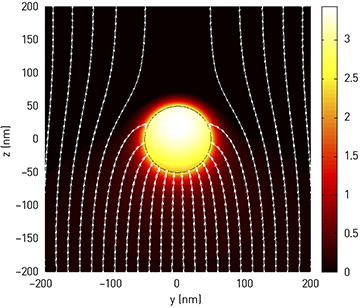 Calculated electric-field strength and direction of incident optical energy for light incident on a 100-nm nanoparticle of excitonic material from below. The light is concentrated onto the particle (arrows) and the field strength is enhanced (color). [M. J. Gentile et al. J. Opt. 18, 15001 (2016)]
Calculated electric-field strength and direction of incident optical energy for light incident on a 100-nm nanoparticle of excitonic material from below. The light is concentrated onto the particle (arrows) and the field strength is enhanced (color). [M. J. Gentile et al. J. Opt. 18, 15001 (2016)]
Confining light to beat the diffraction limit lies at the heart of nanophotonics, enabling the nanoscale processing of light and its integration with other nanosciences and technologies such as electronics, chemistry and biology. For decades, the dominant techniques for achieving the required optical confinement came from plasmonics, in which metallic nanostructures trap and enhance light.
Yet an alternative is now emerging that uses organic molecular structures rather than metallic ones. Building on pioneering work from the 1970s,1 our work has led to the rather surprising finding that molecules that strongly absorb light may also be used to trap and guide that light.
A material’s optical response is described by its permittivity, a complex-valued quantity. A strong optical absorption—for example, due to dye molecules embedded in a polymer matrix—is naturally associated with a peak in the permittivity’s imaginary part. Yet the absorption leads to a substantial change in the permittivity’s real part as well—and if this change is great enough, then the real part of the permittivity may become negative, as with a metal.
Our recent research shows that organic molecular thin films may be used to guide light in the form of surface waves,2 and that molecular nanostructures can localize light in the same way as nanostructured metals.3 The narrowband nature of molecular absorptions means that the required negative permittivity has a limited bandwidth, inspiring new approaches to nanophotonic design. For example, we have shown the possibility of new nanophotonic states (excitonic optical Tamm states) that can exploit this narrow bandwidth property.4 We have also shown that by borrowing the concept of hybridization concept from the molecular and plasmonic worlds, we can significantly extend the bandwidth over which negative permittivity may be achieved.5
We have thus demonstrated that, because of the negative permittivity associated with strong molecular absorption, organic molecular assemblies can be used as building blocks for nanophotonics. This approach to guiding and enhancing light, which is complementary to plasmonics, could open a path to a new nanophotonics that offers the prospect of harnessing the power of supramolecular chemistry and synthetic biology. The result could be a new molecular approach for a fuller integration of light into the nanoworld.
Researchers
Sara Núñez-Sánchez, CINBIO, Universidade de Vigo, Spain
Bill Barnes, University of Exeter, U.K.
References
1. M.R. Philpott et al. Mol. Cryst. Liq. Cryst. 50, 139 (1979).
2. M.J. Gentile et al. Nano Lett. 14, 2339 (2014).
3. M.J. Gentile et al. J. Opt. 18, 15001 (2016).
4. S. Núñez-Sánchez et al. ACS Photonics 3, 743 (2016).
5. M.J. Gentile and W. L. Barnes, J. Opt. 19, 35003 (2017).
